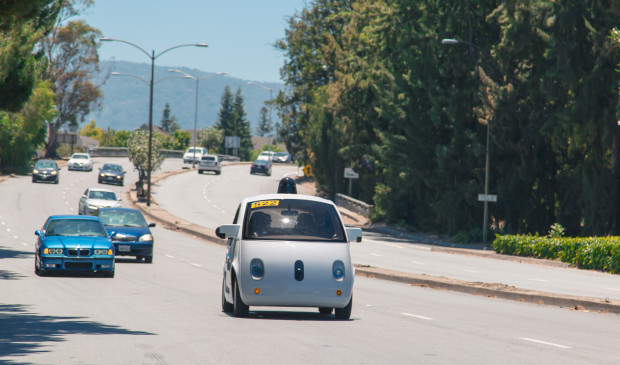Google gears up for new self-driving car in Austin
Thursday, September 3, 2015 by
Tyler Whitson Austinites who have spotted Google’s self-driving Lexus in the past couple of months will have a new rarity to keep an eye out for in the next week or so – the company’s “prototype” autonomous vehicle. Built for the task from the ground up, it sports a futuristic, if unusual, look.
Following Saturday’s announcement, Jennifer Haroon, Google’s head of business operations, explained to the City Council Mobility Committee on Wednesday why Google is rolling out the new vehicle.
“There are a couple of reasons for this,” Haroon said. “One was to think about design choices for a fully self-driving car. For instance, how might we place the sensors so that they have the best field of view possible? Another was, if a vehicle can fully self-drive, then you don’t need manual controls, like a steering wheel or pedals.
“The second reason was that this vehicle is clearly a self-driving vehicle, it looks quite different from most other vehicles on the road,” Haroon continued. “And so, we want to hear from people about how they’re interacting with self-driving vehicles on the road, how they want to use them.”
Google first launched its Austin self-driving vehicle testing program in July. Haroon said that the company initially started with one car – a Lexus sports utility vehicle outfitted with cameras, sensors, computing technology and more – and now has six of them on the road.
Anyone who has encountered any of the vehicles can submit feedback to Google online.
A recent Google press release states that the prototypes will be driving in “a small area north and northeast of downtown” – the same space as the current vehicles.
The new cars will feature a removable steering wheel, brakes and accelerator as well as – like the Lexus – human test drivers to use them, if necessary. They will use the same software as the current vehicles but will be smaller and sleeker, more closely resembling Smart cars than sport utility vehicles, and their components will be more integrated.
Haroon said that speeds will be capped at 25 miles per hour, and the vehicles will act in a “conservative” manner. “Some of the safety features we’ve built in, for instance, are at a traffic stop, when the light turns red to green, the car pauses for one to two seconds before proceeding, because intersections and when lights turn are a place where accidents tend to happen,” she said.
Haroon told the Austin Monitor that she is unable to provide an exact date for the new vehicle rollout, nor is she able to provide the specific testing locations or times. “We definitely don’t want people out there trying too hard to spot them or interact with them in an unsafe way,” she said.
As far as further steps for self-driving cars in Austin, Haroon said it’s too early to say. “I think we really need to build this experience of driving here and of hearing from folks,” she said. “We’ll continue to meet with community members – that’s been a really important part of what we’re doing.”
Another issue that will likely come up as self-driving cars move closer to coming on the market is regulation.
Marissa Monroy, a spokesperson for Austin’s Transportation Department, told the Monitor that there are no state regulations for autonomous vehicles at the moment and that staff has not developed any recommendations for regulating the vehicles.
Efforts to regulate and encourage the use of autonomous vehicles failed in the recent 84th Texas Legislative Session. Since then, Austin has become the first place in Texas for Google to test out its vehicles.
Supporters hope that autonomous vehicles will eventually help Austin overcome some of its traffic woes, particularly those related to accidents and fatalities caused by distracted or intoxicated drivers. First, however, Google and other companies must learn more about how these vehicles interact with human drivers, cyclists and pedestrians.
Photo courtesy of Google.
You're a community leader
And we’re honored you look to us for serious, in-depth news. You know a strong community needs local and dedicated watchdog reporting. We’re here for you and that won’t change. Now will you take the powerful next step and support our nonprofit news organization?









